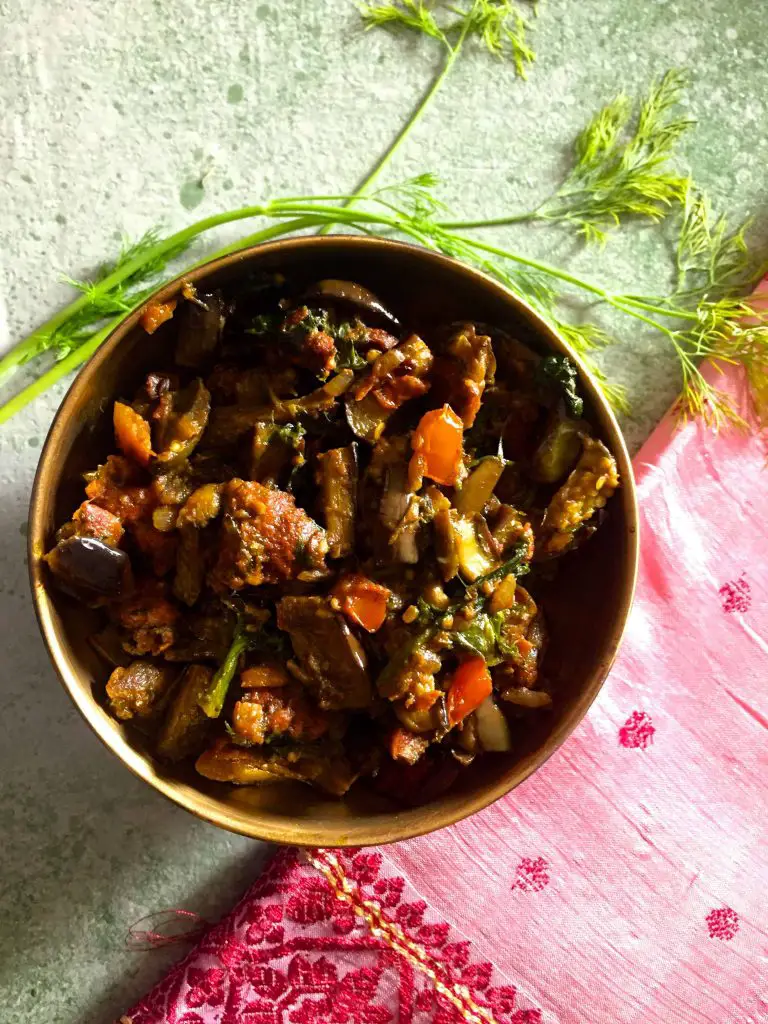
Cooking the State wise dishes of India are part of the monthly theme set by this lovely food blogger group, Shhhhh Cooking Secretly Challenge . Every month each of us is paired up with another blogger, and a theme for the month also decided. Each of the participants name 2 ingredients for their partner, and we have to make and post a picture of the dish using these 2 ingredients. The remaining members of the group have to try and guess the secret ingredients. Its both interesting and a great deal of learning while we research the cuisine of the State for the month.
The theme for December is Bihari cuisine and my partner for the month, the talented food blogger Amrita Iyer (more about her, below) gave me as the secret ingredients – dill leaves and urad dhal (Black gram lentils). As I had fresh purple eggplant, I decided to try and make the badi (or wadi as it is often known - a type of sundried lentil fritters) and the very tasty Baingan Badi Sabzi - Curried aubergine in mustard oil, with Black gram fritters.
Amrita Iyer blogs at The Food Samaritan. Do take a few minutes to check out the blog. It is versatile and interesting, with recipes ranging from food from different Indian regions, to soups and salads, curries and gravies, sauces and cakes! I had given her as her secret ingredients, gram flour and coriander seeds, and she made this delicious looking Papda ki Subzi which I must try out soon too!
While deciding on the recipe I wanted to make for this month's theme, I browsed through Pallavi Nigam Sahay's wonderful cookbook, The Bhojpuri Kitchen. It describes the food of this region and has a number of well explained recipes, all of them mouth watering. I loved the book and am going to make more of these recipes soon. I referred her recipe for Baingan Badi Sabzi for the ingredient quantities, however I did not follow the recipe to a large extent as I made a different version with spinach and dill leaves.
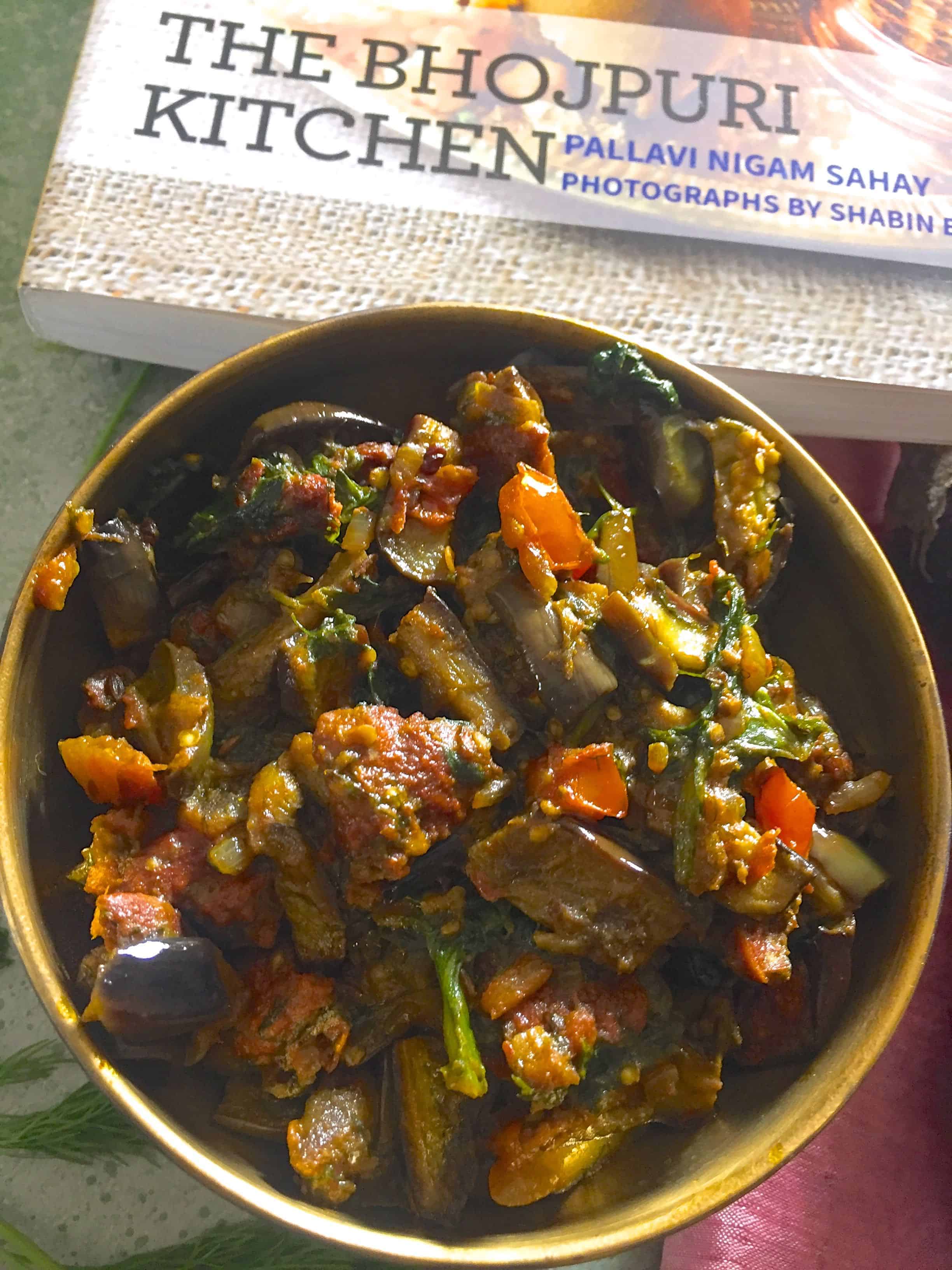
How To Make Baingan Badi Saag Sabji
- In this recipe for making Baingan Badi Sabzi, I have added spinach and dill leaves which actually make it a Baingan Badi Saag Sabzi, a wholesome, nutritious and tasty dish. You may omit the greens if you wish, but I think it adds a lovely dimension to the flavours.
- The spices, greens, herbs and the brinjal with the fried badi is quite easy to put together once you have made the badi and prepped the vegetables.
- I have fried the brinjal slices for a few minutes before cooking them in the curry as this is one way of making the sabzi (and I like fried brinjal more than sautéed or steamed ones) but this is a step you may omit. Instead directly add raw instead of fried brinjal while while cooking and increase the mustard oil in the recipe as well as let the baingan cook longer till they are well done. I had reduced the mustard oil in the recipe as the badi and the brinjal were both deep fried separately and lesser oil was therefore needed in the curry.
Making Urad Dal Badi (Black Gram Fritters)
Many food items in the Bihari cuisine seem to have flour as a component. The famous sattu in some, or gram flour (basen) or rice flour or, as in this recipe, urad dhal flour. A few days before I planned to make the Baingan Badi Sabzi, I soaked urad (black gram lentils overnight) and then ground them into a batter with cumin seeds and very little water. After this I made the little badis and sun dried them for 3 days.
The urad dhal badi dried well even in the lower intensity of December heat, and fried into crisp little badis. It was easy to make them, but badis are available ready made in many places in Northern India and you may choose to get them from the store instead of making the urad dhal badi from scratch. I have therefore not added the time for making the badi, in the recipe details. However if you plan to make badi at home, you need to plan at least 3 sunny days ahead of time before you can actually make Baingan Badi Sabzi.
More Curries With Brinjal Or With Badi
"Recipe"
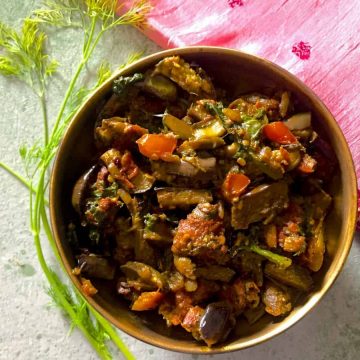
Baingan Badi Sabzi - Curried Aubergine with Black Gram Fritters
Ingredients
To make Urad dal Badi from scratch
- ½ cup black gram/ urad dhal sabut Black gram lentils -whole
- 1 teaspoon Cumin (Jeera) seeds
- 1 pinch hing powder asafoetida
- 1 pinch salt
- water for soaking and grinding
For frying urad dhal Badi and the Baingan
- 1 cup sunflower oil or other mild vegetable oil
- ½ cup Badi
- 4 cups Brinjal sliced thin Aubergine or EggPlant
- ⅛ teaspoon salt
For Baingan Badi Subzi
- 1-2 tablespoons mustard oil or other vegetable oil
- 1 teaspoon Cumin (Jeera) seeds
- ½ teaspoon Fenugreek (methi) seeds
- 2 Dry red Chillies Stalks removed
- 1 cup onion
- 1 teaspoons garlic minced
- 1 teaspoon ginger minced
- ⅛ teaspoon asafoetida hing powder a pinch
- 1 cup tomato
- 1 cup Dill leaves
- 1 cup Spinach leaves
- ½ teaspoon turmeric powder
- ½ teaspoon amchur powder (dried mango powder)
- ½ teaspoon Chili powder
- ½ teaspoon garam masala
- 1 teaspoon salt or to taste
Instructions
Preparation for Baingan Badi Sabzi
- Slice onions into small pieces. Peel and mince the garlic and ginger. Dice the tomatoes into small cubes. Remove stalks from red chillies and break them if desired Wash, drain and dry the dill and spinach leaves in a salad spinner or in a kitchen towel to remove as much of the water as possible. Chop the leaves and wrap in a damp towel till required. Keep all ingredients ready so that you can quickly add them one by one to the curry as required.
- Slice the brinjals last of all, into 2 cm long thin pieces. Sprinkle a little turmeric and toss them to delay the browning, or else immediately start the frying process as in instructions below.
- Heat the oil in a small pan. Add badi to the hot oil. Reduce the heat and fry the badi, turning them over periodically with a slotted spoon. Drain the oil and remove the badi from the pan when the colour darkens to brown (without letting them go dark or black). Set aside, till required.
- Heat the oil in which the badi was fried and add the brinjal slices in batches, taking care not to overcrowd the pan. You want to deep-fry and not sauté or steam the brinjal. Reduce the heat when the slices are added, and fry each batch for about 3 minutes. Drain the oil and remove each batch to a bowl. Set aside till required.
To make the Baingan Badi Subzi
- In a fresh pan, heat mustard oil. On low heat, add the cumin (jeera) seeds. Sauté for 10 seconds and add fenugreek (methi) seeds. Sauté till they sputter/burst. Add dry red chillies, whole or broken as preferred. Sauté for 20 seconds, turning the chillies so that all sides are fried.
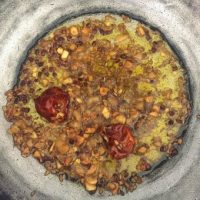
- Add garlic and ginger, sauté for about 2 minutes on low flame. Add the sliced onion, saute for 3-4 minutes on low heat, stirring occasionally, till they begin to brown and darken.
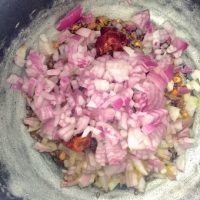
- Add the chopped tomatoes. Add the chopped dill and spinach leaves. Sauté for 2 minutes.
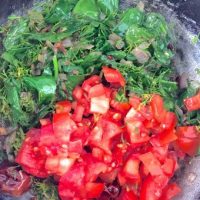
- Add the masalas: turmeric powder, chilli powder, hing, one by one, stirring lightly. Saute for 2 minutes, stirring frequently as the masalas may stick to the pan and char.
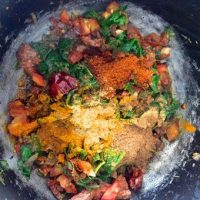
- Break the fried badi into pieces and add. Stir.

- Add the sliced fried brinjal, stir. Add garam masala and amchur powders. Add salt to taste, and stir well. Cook on low heat till the brinjals are soft and cooked through, stirring frequently as they may catch at the bottom of the pan. Once the brinjal is cooked, remove the curry from the stove and serve hot with chapatis or with rice and dhal
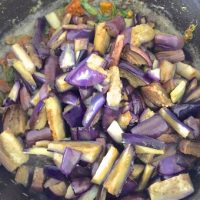
To make Urad dhal Badi from scratch
- Rinse and then soak the whole urad dhal in water sufficient to cover the dhal, overnight. Next morning, drain the water and wash the soaked dhal 2-3 times, drain again and grind the dhal with the cumin seeds into a paste, using as little water as possible. The lesser the water, the quicker the badi will dry and the batter will have the consistency required for shaping it. Add salt and hing powder and run the mixie once more so that they spread evenly in the batter. The batter may be coarse however the cumin should have ground completely. Transfer the batter to a bowl and beat it and check the consistency. You need to be able to lift spoonfuls of batter to sun dry, but it should not flow easily either. If you are not able to lift a spoonful of batter, add a teaspoon of water at a time, mix, and try again.
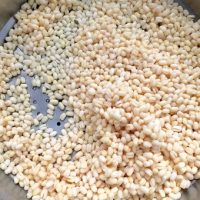
- Using a clean cloth or spreading a little oil on trays or plates, drop spoonfuls of the batter onto the cloth or tray. Or wet your fingers slightly and drop small portions of the batter onto the tray. Try to make them even sized and leave space for the badi to spread a little as it dries. I made small badis but you can make them larger.
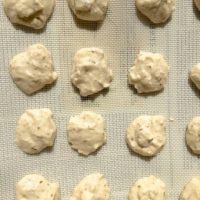
- Dry the badi in the sun for 2-3 days till one side of the badi is dry. Turn each badi over so that the other side gets the sun, and dry again for at least one more day till the badi is completely dry and can be broken into pieces by hand. When sun drying, keep the badi out in sunlight in the morning, and take it back once the sunlight goes away in the late afternoon or evening. I placed the badi for drying on a silicon baking sheet and covered it with a clean net to protect it from birds. Once completely dry, remove the badi from the cloth/ tray and store in an airtight container.

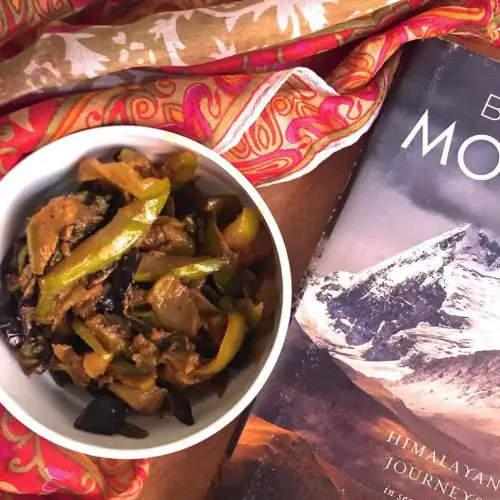
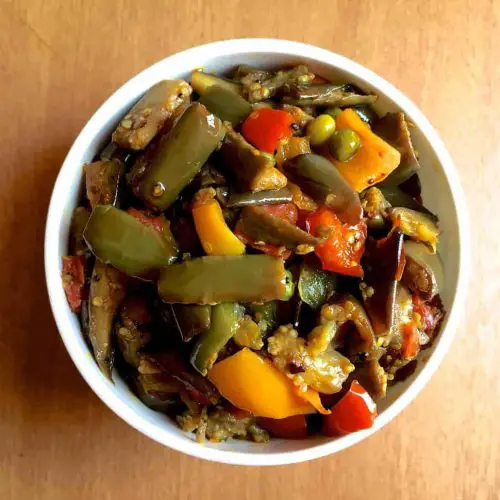

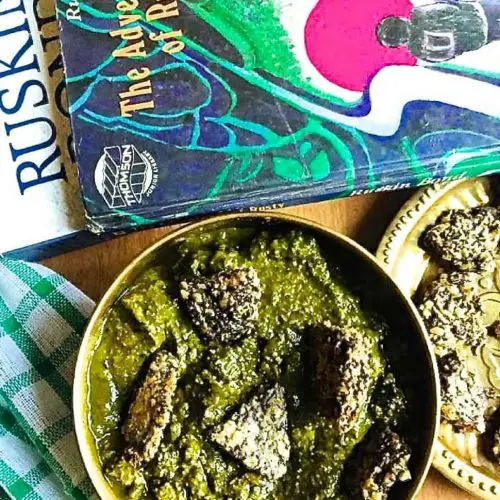

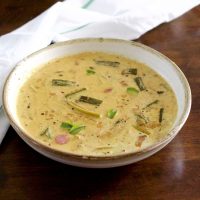
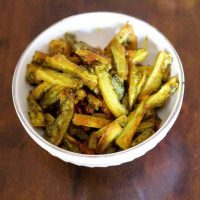
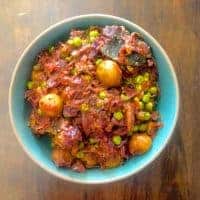
mayurisjikoni says
I love any sabji with badi in it. Baigan Badi Sabzi looks so tempting. Your badis are all the same size 🙂
ammu163 says
This subzi looks absolutely delicious!You have done justice to Bihari cuisine marvellously!
Sujata Shukla says
Thank you! I’m glad you liked the post!
The Girl Next Door says
Fantabulous share! Wow! I can't wait to try this out myself. 🙂
The Girl Next Door says
Wow, wow, wow! I can't wait to try this out myself. Fantabulous share! 🙂
Priya satheesh says
Loved the recipe.. Sabzi looks so yummm..Bookmarked it to try it sometime !
Sujata Shukla says
Thanks Priya! The badi gave a nice contrast in textures!
poonampagar says
The baingan badi saag subzi looks just wow di...loved the fact that you even prepared the badi at home 😃
Sujata Shukla says
Thank you Poonam! I had fun making this!